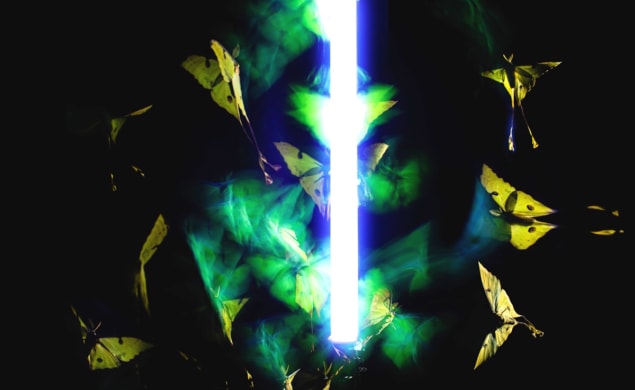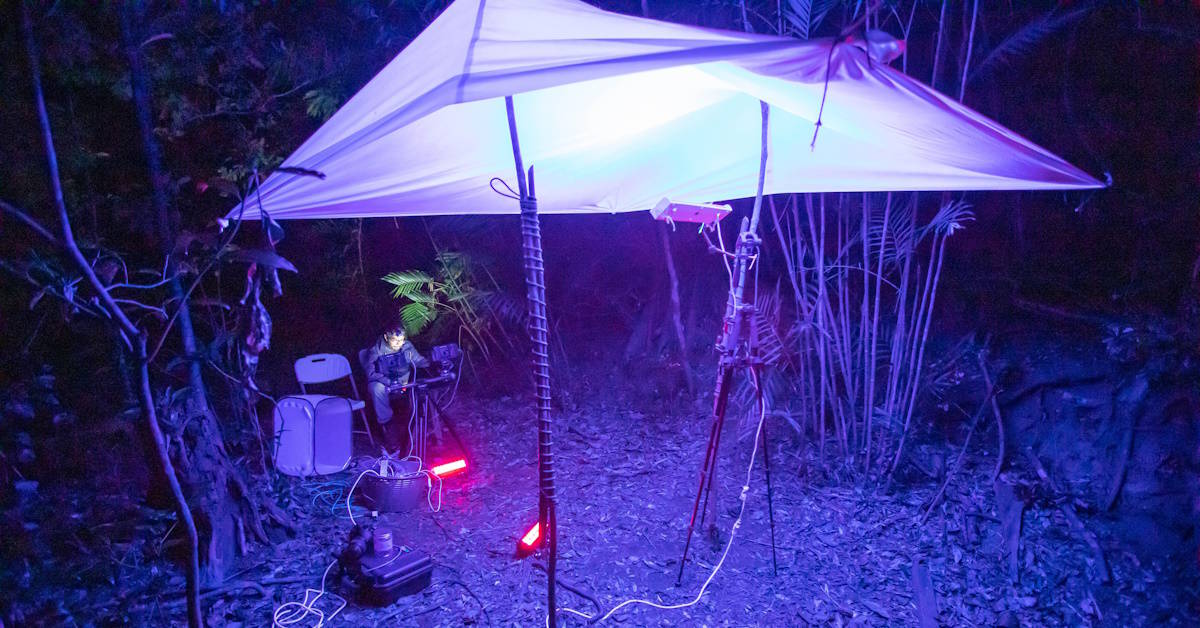
We’ve all experienced it. You’re sat outside – perhaps camping with a lantern, perhaps relaxing in your garden, or maybe even walking home with a torch – and then suddenly, there are swarms of insects gathering around the light. It’s a phenomenon that’s been seen for many years, and an approach that has been used to trap insects since Roman times. But until now, the reason why insects exhibit this behaviour has eluded scientists.
Sam Fabian from Imperial College London, Yash Sondhi from Florida International University, and their wider research teams have now resolved this mystery. When asked why it’s taken so long, Fabian and Sondhi agree that “there’s been a technical difficulty in trying to track fast moving animals, especially at night-time”.
“A housefly is travelling at hundreds of body-lengths per second. For its size, this is an order of magnitude more than the fastest fighter jets,” says Fabian. “To some extent it was this belief that it was such a hard question, that there wasn’t much point in trying to answer it, because so many people had tried and got it wrong,” adds Sondhi.
Many theories have been proffered into how and why insects gather around artificial light and stay there, from the Moon acting as a celestial compass, to thermal radiation attracting insets, to their eyes being blinded by artificial light. However, Sondhi tells Physics World, “the idea that all insects, especially moths, needed to fly in a straight line and use the Moon’s position to navigate felt like it was ignoring a lot of basic ecology and didn’t feel like it should explain such a large range of behaviours. 3D trajectory and video data would shed light on what might be happening.”
Until recently, 3D tracking of small flying insects in low-light environments was technically challenging, and there weren’t the tools available to get a realistic picture of what was happening. However, understanding how and why insects interact with artificial light has become a more pressing matter in recent years due to the increase in urban light pollution that is contributing to insect decline.
Which way is up?
Many flying insects display a dorsal light response, a behaviour where their dorsal (top) side faces the brightest region. Understanding this, the researchers used high-resolution motion capture in the laboratory and high-frame rate stereo-videography in the field to capture the effects of artificial light on different insect flight trajectories at night.
The researchers captured flight data on both the flightpaths of wild insects near an artificial light source in the field and the free-flight body orientations of captive insects. They used the data from these two processes to reconstruct the 3D kinematics of insect flights around artificial lights.

While a lot of theories have been centred around attraction, the team found that the insects do not steer directly towards the light, but instead turn their dorsum towards the light. In natural light, this tilting helps insects to maintain the proper flight attitude and control. However, the models developed by the researchers showed that dorsal tilting creates the erratic flight paths around artificial light, causing the insects to continuously steer around the light and become trapped in a constant motion.
“It is the idea that short-range light entrapment is not a navigational disruption, but instead subversion of a basic flight stability reflex, predicting that requirements for stable flight can explain this phenomenon,” says Sondhi.
“The most standout result is that artificial lights confuse insects as to which way is up,” Fabian tells Physics World. “On the ground, we find this obvious. In the air, this is a lot more challenging. In-flight accelerations are indistinguishable from acceleration due to gravity. Simply taking the direction of light as being the sky works, even at night. The night has a lot less light, obviously, but the contrast between sky and ground is just as strong. This is a beautiful, robust way to work out which way is up – until we started lighting up the night.”
What comes next?
While this research has managed to solve an age-old question, there is still more work that can be done. When asked about the future of this research, Fabian and Sondhi point out that “we don’t know what’s happening further away from light sources, as our study focused on insects within a few metres of the light, so we would like to improve tracking technology to see if we can answer this, as well as to see how their response varies with different lighting”.

Lidar tracks mosquito behaviour by monitoring wingbeats
Beyond this, Fabian says that the team would like to “use this response to understand more about insect flight control. We can use lights to get insects to adjust their posture in flight, and in doing so learn about the wing and body movements that create this response”.
“We would like to examine how the mechanism for this has evolved across different insects, and what non-visual mechanisms can override or act redundantly when visual verticality sensing is disrupted,” says Sondhi. Clearly, there’s still a lot of research in the pipeline.
The research was published in Nature Communications.
- SEO Powered Content & PR Distribution. Get Amplified Today.
- PlatoData.Network Vertical Generative Ai. Empower Yourself. Access Here.
- PlatoAiStream. Web3 Intelligence. Knowledge Amplified. Access Here.
- PlatoESG. Carbon, CleanTech, Energy, Environment, Solar, Waste Management. Access Here.
- PlatoHealth. Biotech and Clinical Trials Intelligence. Access Here.
- Source: https://physicsworld.com/a/researchers-solve-mystery-of-why-flying-insects-gather-at-artificial-light/
- :has
- :is
- :not
- :where
- $UP
- 150
- 3d
- 7
- a
- About
- above
- acceleration
- across
- Act
- acting
- Adds
- African
- age-old
- AIR
- All
- Allowing
- an
- and
- animals
- answer
- approach
- ARE
- around
- artificial
- AS
- At
- attitude
- attracting
- attraction
- available
- away
- basic
- BE
- beautiful
- because
- become
- becoming
- been
- behaviour
- behaviours
- being
- belief
- between
- body
- both
- Bright
- brightest
- but
- by
- CAN
- capture
- captured
- causing
- ceiling
- challenging
- clearly
- click
- College
- comes
- Compass
- constant
- continuously
- contrast
- contributing
- control
- create
- creates
- data
- Decline
- developed
- different
- Difficulty
- direction
- directly
- Display
- disrupted
- Disruption
- do
- doing
- done
- Dont
- due
- effect
- effects
- eluded
- environments
- especially
- Even
- evolved
- examine
- exhibit
- experienced
- Explain
- extent
- Eyes
- faces
- FAST
- fastest
- feel
- felt
- few
- field
- Find
- flight
- Flights
- florida
- flying
- focused
- For
- found
- from
- further
- future
- Garden
- gather
- gathering
- get
- got
- gravity
- Ground
- had
- Happening
- Hard
- Have
- helps
- High
- high-resolution
- Home
- How
- However
- HTTPS
- Hundreds
- idea
- if
- image
- Imperial
- Imperial College
- Imperial College London
- improve
- in
- Increase
- information
- instead
- interact
- International
- into
- issue
- IT
- ITS
- Jets
- jpg
- just
- Know
- laboratory
- large
- LEARN
- less
- light
- Lighting
- like
- Line
- London
- Long
- Lot
- Lunar
- maintain
- managed
- many
- many people
- matches
- Matter
- max-width
- maybe
- mechanism
- mechanisms
- might
- models
- monitoring
- Moon
- more
- mosquito
- most
- motion
- Motion capture
- movements
- moving
- much
- Mystery
- Natural
- Nature
- Navigate
- Near
- needed
- next
- night
- now
- obvious
- of
- on
- open
- or
- order
- our
- out
- outside
- override
- paths
- People
- per
- perhaps
- phenomenon
- Physics
- Physics World
- picture
- pipeline
- plato
- Plato Data Intelligence
- PlatoData
- Point
- Pollution
- position
- predicting
- pressing
- processes
- proper
- published
- question
- range
- Rate
- realistic
- reason
- recent
- recently
- region
- Requirements
- research
- researchers
- resolved
- response
- result
- robust
- roman
- Sam
- says
- scientists
- Second
- see
- seen
- shed
- sheet
- should
- showed
- shrouded
- side
- simply
- since
- Size
- Sky
- small
- So
- SOLVE
- some
- Source
- Sources
- Stability
- stable
- standout
- started
- stay
- steer
- Still
- straight
- strong
- Study
- Studying
- such
- taken
- taking
- team
- teams
- Technical
- technically
- Technologies
- Technology
- tells
- than
- that
- The
- The Future
- their
- then
- There.
- thermal
- These
- they
- this
- thomas
- thumbnail
- times
- to
- tools
- top
- torch
- towards
- track
- Tracking
- tracks
- trajectory
- trapped
- tried
- true
- trying
- TURN
- two
- underneath
- understand
- understanding
- university
- until
- urban
- use
- used
- Video
- visual
- walking
- was
- Way..
- we
- WELL
- What
- when
- which
- white
- why
- wider
- Wild
- wing
- with
- within
- without
- Work
- work out
- works
- world
- would
- Wrong
- years
- Your
- zephyrnet













